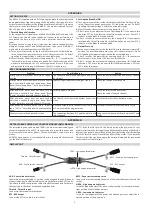
www.apcoaviation.com
Figure
12-1 Brake Line Adjustment
12.3 FIRST CHECK AND PREFLIGHT INSPECTION
With every new glider, check the following:
Connection points between the glider and the harness.
No lines twisted, tangled or knotted.
The risers and speed-system are hooked up to the harness correctly.
12.4 REGULAR INSPECTION CHECKS
Damage to lines, webbing and thread on the stitching of the harness and risers.
All stainless steel connection links on the risers are not damaged and are fully
closed.
The pulleys of the speed system are free to move and the lines are not twisted.
The condition of the brake lines, stainless steel ring and knot attaching the brake
handle to the brake line.
The sewing, condition of the lines and connection of the lines.
Damage to hook up points on the glider.
Internal damage to the ribs and diagonal ribs.
Damage to the top and bottom panels and seams between panels.
12.5 LINE MAINTENANCE
Four groups of suspension lines and one brake line are attached to each riser. The
four groups are called A, B, C, D and brake lines. The stabilizer lines are connected
along with the B-lines. Superaramide lines are known to be sensitive to the influence
of the elements. They must be carefully inspected periodically. In his/her own
interest, the pilot must observe the following points to ensure maximum performance
and safety from the glider.
Page 12 of 24
Summary of Contents for Play 42 MK-II
Page 9: ...www apcoaviation com Page 9 of 24...
Page 20: ...www apcoaviation com 21 PLAY42 SKETCHES AND CERTIFICATION 21 1SKETCHES Page 20 of 24...
Page 21: ...www apcoaviation com Page 21 of 24...
Page 23: ...www apcoaviation com 22 PLAY42 MK II SKETCHES Page 23 of 24...
Page 24: ...www apcoaviation com APCO wishes you many hours of enjoyable flying Take Air Page 24 of 24...










































